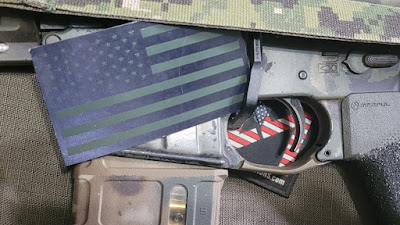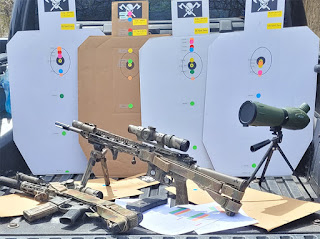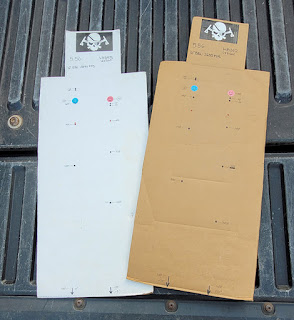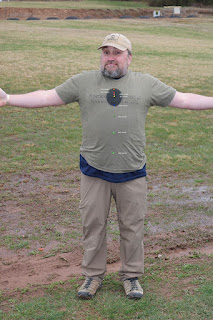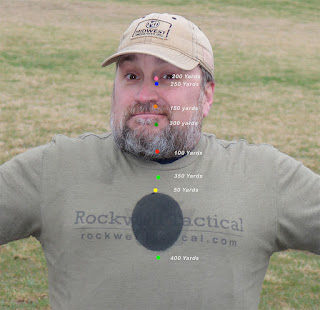Here in the good ole US of A, we have a thriving gun culture. Guns have been part of our DNA since the very first day of us being our own nation (See “Gun confiscation attempted” in Lexington and Concord.)
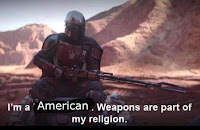 We, as a nation, nearly invented the Mandalorian religion. Our rugged history shows how we integrated the gun into daily life. In those formative years, it was common for a dude to be fully skilled prior to joining the Army and going to war. Even in the 20th century, many guys went to war knowing how to fight and shoot before they signed up to do so on foreign soil.
We, as a nation, nearly invented the Mandalorian religion. Our rugged history shows how we integrated the gun into daily life. In those formative years, it was common for a dude to be fully skilled prior to joining the Army and going to war. Even in the 20th century, many guys went to war knowing how to fight and shoot before they signed up to do so on foreign soil.I don’t think, as a whole, we are that people any longer. Sure, the nation doesn't have a dangerous frontier any longer, and society has tried its damnedest to demonize guns, which have all had some effect. But there seems to have been a change inside the collective of “gun guys” as well.
Don’t get me wrong, we have an unprecedented number of gun owners, shooters, hobbyists, and such. The disconnect from before is the amount of shooting vs. the amount of all the other stuff those before us would bring to the table. I’m uniquely positioned as a full-time trainer to see a larger swath of “gun guys.” Not the typical cat who looks for deals at his local gun shows and buys stuff because it looks cool and is cheap. Not the typical Fudd type. At $250 per training day, dudes who come to class are more serious than the typical gun owner. These “serious-er” gun guys are the ones that typically fill classes.
The part that surprises me most is the percentage of those guys who end their skillset on the range. They love guns; they have a lot of them, have a lot of ammo, and shoot a lot of ammo through those guns. A good portion of those cats can shoot. It makes the teaching part on Day 1 easy. But they are satisfied with that being their entire relationship with guns. The last time they were in the woods was with a 3 room tent pitched beside their station wagon in a commercial campground. Their iPhone is the only tool they can use to find that campground, and they didn't even bring a gun since they were going to be at the adjoining waterpark the entire time.
I’ve had this discussion with colleagues and peers; we often discuss the “why” and come up with a multitude of possibilities. Economic success coupled with lower manufacturing costs kept cropping up, which I hadn’t necessarily thought about on my own, but in a moment, I’ll try to illustrate how that's a distinct possibility.
The US has been so prosperous for so long that it is not only more affordable to “get into” something, and generally, people have more income to do so. Of course, that’s a recipe for divided attention, but one of the aspects of 4 years ago vs. 40 years ago is the economy of shooting. Bullets are cheaper, and there’s more money to buy them. Hell, as a kid, I never saw a case of rifle ammo. I don't think I’ve purchased it in any size smaller than a case in the last decade. That makes it easy to spend a lot of time behind a trigger. And the alarming trend I see is that time comes at the expense of time spent getting good at the other things that matter.
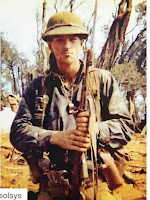 |
| The Best ever in the woods. |
I’ve been following some dudes from a European country where gun ownership is a thing, but shooting a thousand rounds a week generally isn't. These dudes are humping those guns up in the mountains a few weekends every month. They plan and execute a trip with all the logistical requirements to navigate a dozen guys 15 miles away, sustain themselves while they are there, build fighting positions, and then return home. They do this year-round, in all the weather that keeps the average “gun guy” from even going to the range. These dudes, who are not fully immersed in a “gun culture,” would devour most dudes who like “tiny groups, machine gun pace” in most armed conflicts. Why do these cats do this? Because they don't have 5 different ranges within a half-hour drive. They don't buy ammo by the pallet to specialize in just one fraction of skills. When they do go shoot, they make it count and go with a plan for every round spent. In between, they train for free in skills that will make the fight. Gun guys here? “Aint got the time.”
 |
| These aren't the dudes referenced, but you should follow them too. |
The part that surprises me the most is that ammo costs since the beginning of the Wuhan shutdowns have increased significantly. There was some incentive to train more economically. Barely made a blip on the radar. The fear of the world going to shit did have a huge effect. People embraced preparedness. I’ve seen many more people growing food, raising chickens, and stockpiling wheat for longer-term storage. Although the Wheat thing is surprising since most folks will need somebody else to help them figure out what to do with it. There was a proverbial “wolf at the door” (Tom Wolf here in PA), which got them to alter course. But it didn’t seem to alter their course when it comes to fighting skills that aren't “one ragged hole, at cyclic rate.” Now they have a lot of guns, a lot of ammo, and a lot of food and supplies. They still shoot well, and if their imaginary fight looks like the final scene of Young Guns, they will likely perform spectacularly.
When we do live-fire study groups, we get 10-25 people to attend. They get their shoot on. Significant cost money for ammo, targets, and range rental, but they come out to blast away. We do some Land Nav for free, and we’ll get 8-10. We spend a night in the woods after doing some land nav/patrolling, and it’ll be 6. Just yesterday, we went out in the snow. Rucked a couple of miles and built an OP/LP. In the cold, hard work with shovels, picks, and saws netted us 4 participants. I intend to ask every student I have in class this year if they have ever built an OP/LP, and I’d wager that number will be pretty small, yet nobody came out to do that at no cost.
At the end of this, you may say, “ Garry, ok. But what’s your point?” I’d like to say I have a solution, but I don't, or I’d have better numbers in the previous paragraph. But Maybe just raising awareness is the point, and maybe somebody reading this will realize it’s them that I’m talking about.

